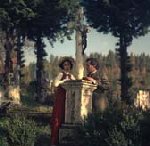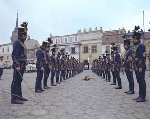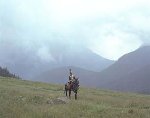 |
Vol 2, No 4
31 January 2000 |
|
|
The Eye Speaks An interview with cinematographer-turned-director Sándor Sára Andrew J Horton That Sándor Sára was able to attend a short retrospective of his films in London might not seem so strange. But Sára's appearance was quite remarkable when you consider that the 66-year-old cinematographer-turned-director is still active in cinema as well as being president of Duna TV, the Hungarian satellite channel, which won a UNESCO award for its cutural coverage last year. Indeed, Sára arrived not from Hungary, but flew in from India, where he is filming his latest documentary.After the screening of four films which he was involved in at the Riverside Studios in Hammersmith, London, CER met Sára to discuss his various careers. Even he had to joke about his CV, saying that its diversity was "unfortunate."
SS: Yes, I think that's a valid point. I see the image as very important. Recently, quite a few people have turned away from the image itself and there are a lot of films in which there is a great deal of speech. But I prefer topics which can be expressed best by images or a series of images. Apart from that, however, I regard each and every shot as being very important. Maybe this comes from the fact that when I started studying cinematography at the academy in Hungary we first made stills and in a still you have to get your message very precisely. Even today, I like still photography very much and I take photographs myself. I've just returned from India and I took a great deal of photos there. In Szindbád (Sindbad, 1971) and Tüske a köröm alatt (A Thorn Under the Fingernail, 1987) the images are cut very rapidly, whereas other poeticists would present long slow shots.
When you started as a cinemtographer in the 1960s, you had a lot greater influence over the photography as a creative process than was normal at the time. How did directors feel about giving up this creative control to you? Well, it started at the Academy [for Theatre and Film Art in Budapest]. I was in the cinematography group, and there was the directors' group. Every term we had to create an assessed film together with the directors and even then we felt that we were subordinate to or dependent on the directors. If we were lucky the directors were thinking in terms of images but if not that made it very difficult. So therefore three of us, and I was at the forefront of this, were fighting for and eventually managed to get it so that we cinematographers made and directed the films ourselves.
A very important factor was that I didn't make that many films and whenever I worked with directors they were friends or people I knew very well and we trusted each other perfectly. One example is István Gaál. I was the cinematographer for his film Sodrásban (Current, 1963). But in the documentary Cigányok (Gypsies, 1962) I was the director and he did the cinematography. And then he didn't let me look into the camera. You've worked as a director of fiction and of documentary films. How are they different for you? Documentaries are dead serious things and even though a feature film is serious, in Hungarian it is called játékfilm or a "play film" so there is an element of play and play is always better. I made some really horrific documentaries about the Second Hungarian Army and women in the Gulag. And when we shooting these films there were about five of us in the team and we were depressed for months by these appalling stories. In feature films, of course, there are dramatic moments which are the work of the actors on the director and there cathartic moments which do have an effect on the people who shoot the film. But when its over we can go and have a drink together, but you can't do that with a documentary.
For the last seven years you have been president of Duna TV, and yet you are still making films. How do you manage to fit that into schedule? With difficulty, since I've become president, I've only made one feature film. There is one screenplay which is now ready and I have other plans as well. But even if I weren't president of Duna TV, I don't think I would have made that many more films as to create the financial background for a film in country takes years. Duna TV recently won a UNESCO award for its cultural output, much of which is connected with covering Hungarian culture in Slovakia, Transylvania and Vojvodina. Nobody seriously believes in Greater Hungary as a geopolitical possibility anymore, but do you think you have a mission to create a united spiritual or cultural Hungarian nation out of these divided geographical parts? No-one within the current geographical borders or beyond it thinks that this could be one nation . But everyone feels that they are together. Let me give you an example, the man you saw me speaking to earlier this evening is a fellow Hungarian, a senator to the Romanian parliament. And we meet in London! But not like people who come from another country. I think the common features of the culture, the language and the traditions do unite us.
Andrew J Horton, 31 January 2000 Click here to read the Kinoeye review of Sára's career as seen through the London retrospective.
|
|
![]()
Copyright © 2000 - Central Europe Review and Internet servis, a.s.
All Rights
Reserved





